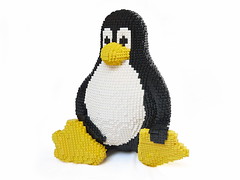| Name of Model: Tux |
| Created by: Steffen "Asperka" Rau |
| Found at: https://www.flickr.com/photos/66636161@N00/sets/72157646874722554 |
Details:  I've recently written about the increasing popularity of building sculptures with studs facing out in all directions. It allows for a stunning level of precision in a model, making it pop with realism. This one's a bit different than most of the others I've blogged in the past, though: most of the shape of this model was generated by a computer. LSculpt has been around for a while, but for us LEGO Open Source junkies (I know I'm not the only one), it's exciting to see it used to make RepRap's version of the iconic Linux mascot, Tux the penguin, exist in the brick. Sure, sure, it's not that difficult to build a model from computer-generated instructions, but it's no mean feat to track down all the right pieces for a model on this scale (50 cm/63 studs/20 inches tall), and most of standing out in the LEGO community is more about having good ideas for what to build than about how clever you are with LEGO techniques anyway. It's hard to overstate the cleverness of the complete Free Open Source Software chain here - a Linux penguin, colored in GIMP, modeled in Blender, run through LSculpt. I've recently written about the increasing popularity of building sculptures with studs facing out in all directions. It allows for a stunning level of precision in a model, making it pop with realism. This one's a bit different than most of the others I've blogged in the past, though: most of the shape of this model was generated by a computer. LSculpt has been around for a while, but for us LEGO Open Source junkies (I know I'm not the only one), it's exciting to see it used to make RepRap's version of the iconic Linux mascot, Tux the penguin, exist in the brick. Sure, sure, it's not that difficult to build a model from computer-generated instructions, but it's no mean feat to track down all the right pieces for a model on this scale (50 cm/63 studs/20 inches tall), and most of standing out in the LEGO community is more about having good ideas for what to build than about how clever you are with LEGO techniques anyway. It's hard to overstate the cleverness of the complete Free Open Source Software chain here - a Linux penguin, colored in GIMP, modeled in Blender, run through LSculpt.There's also that nose - zoom in on the photos and you can see that care was put in to use tiles to round things out just a little more than LSculpt suggested. You'd be surprised how often small details like that end up being what separates a builder who really knows what he/she is doing from someone who is building directly from a program. Also adorable: this comparison shot with other versions of Tux, and this close-up of a version of Tux scaled to Mixel eyes. It's also noteworthy for historical reasons (and comparison's sake) that Eric Harshbarger (in many ways the first big freelance LEGO sculptor) has built Tux in a more traditional studs-up style, without the aid of modern programs or techniques. Newer tools and tricks have a way of making awesome models seem less exciting in retrospect (as they say, nostalgia isn't what it used to be). |
Tuesday, January 6, 2015Tux, the Linux Penguin, in Studs-Out Sculpture FormPosted by Dan at 1:11 AM
Posted by
Dan
at
1:11 AM
Labels: Adult Fan of Lego, lego, sculpture, techniques |
Subscribe to:
Post Comments (Atom)
No comments:
Post a Comment